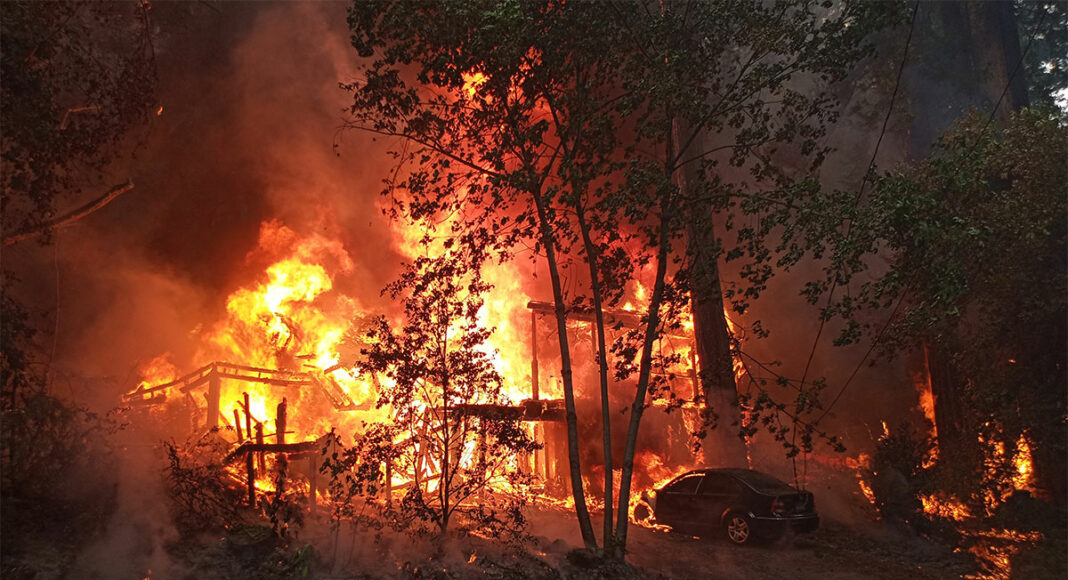Residents of Bonny Doon and Boulder Creek have begun moving back to the area threatened by the CZU Lighting Complex fire, which is 91% contained as of Tuesday morning after burning 86,509 acres. Residents are grappling with questions about water supply, water quality, road repairs and so much more as they try to get on with their lives.
But as the smoke continues to clear in the Santa Cruz Mountains, they are asking another question: How did this happen?
Ian Kapostins, a resident of Last Chance, remembers seeing the sky suddenly catch fire on the night of Aug. 18, as a thick, gusting, ember-filled wind blew through his backroad neighborhood. Kapostins rushed his wife out of a shower, and they gathered up the cats, got in the car and floored it down Last Chance Road as flames engulfed their neighborhood. Although fires had been burning for a few days, Kapostins and his neighbors never got an evacuation warning.
Media reports have since detailed the harrowing experience of the Kapostins’ neighbors—the death of longtime resident Tad Jones, the horror of spending the night in an open meadow while flames closed in, and hiding out in a pond with a pipe for a snorkel. It all happened hours after Last Chance residents were repeatedly assured they’d be safe.
Kapostins’ home was one of more than 900 to burn in the fire. He says he has no beef with Cal Fire, which he knows was stretched thin due to historic wildfires blazing throughout the state. But as he shifts gears to think about rebuilding, he just wants to make sure it doesn’t all happen again.
“We do see that something fell apart,” Kapostins says. “We’re totally supportive of what they do, but we want to help them do it better.”
ASH PROMISED
In the years ahead, there will be a report looking into what happened in the CZU Lightning Complex fire. There will also be a close look at how best to structure fire services in the county.
The Land Agency Formation Commission of Santa Cruz County (LAFCO) was already planning to spend the next year working on a review of fire services in the county. Then came a scathing report earlier this summer from the Santa Cruz County Civil Grand Jury detailing systemic issues among the county’s 10 fire districts. Among its concerns, the Grand Jury argued that the current setup creates a confusing web of bureaucracy that provides little accountability. That prompted a recent response from LAFCO and cast a spotlight on the agency’s coming analysis.
As an example of what will be on the table, LAFCO staff could recommend the consolidation of different agencies—if they determine that such changes would be more efficient, more sustainable or safer.
Because so many of the fire safety issues outlined by the Grand Jury are organizational, it is too early to say whether the bulk of them made the CZU fire any worse. But the crisis has shone light on this pivotal moment between a major Grand Jury report and the anticipated analysis.
Local LAFCO Executive Officer Joe Serrano was working at the San Diego branch of LAFCO after fires terrorized southern California in 2008, and he saw firsthand how the agency played a leading role in reorganizing fire services in San Diego County.
He says Santa Cruz County’s LAFCO could play a similar role locally as the community works on how to move on. That’s why Serrano looks forward to digging more deeply into the Grand Jury’s findings.
“They raised good questions, so I really want to continue that analysis,” he says. “After these fires extinguish, we’re going to see what went well and what didn’t. What were the lessons, and how can we prevent this from happening again or minimize those effects?”
DISTRICT PROTOCOL
When it comes to merging two or more special districts, Santa Cruz County Supervisor John Leopold, a longtime LAFCO commissioner, says it takes lots of hard work and years of collaboration.
LAFCO played a role in the Aptos/La Selva Fire Protection District’s merger with Central Fire—which LAFCO is expected to approve next month—as well as the merger of the Lompico Water District with the San Lorenzo Valley’s. The Grand Jury was also involved in both of those. In many instances, however, Leopold says that Grand Jury and LAFCO recommendations go unheeded.
Individual special districts, like water districts and fire districts, meet the needs of the customers in various ways, and there are always lots of details to work out, he says, to see the process through. One of those hurdles can be that a community will often root its sense of identity in its small-town water district or fire protection district—even when that value appears largely symbolic.
“Fear of losing that identity is one of the factors that can complicate the logistics of mergers,” Leopold says.
Fellow LAFCO commissioner Jim Anderson, who serves on the Felton Fire Protection District’s Board of Directors, said at a Sept. 2 LAFCO meeting that he has a certain fondness for the San Lorenzo Valley’s fire departments, all of which are volunteer-run. Still, he thinks it’s important to leave the door open for changes, including the possibility of a consolidated system of stations, staffed by paid firefighters.
Serrano says the whole process is just getting started, and there’s no telling where it will lead.
“These reports plant a seed of an idea,” he says. “An opportunity.”













